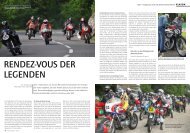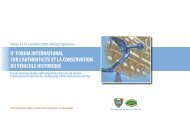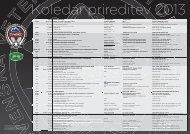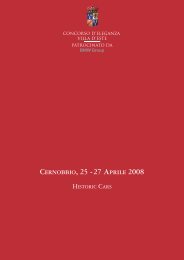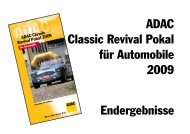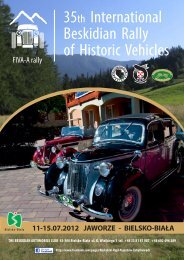FORUM INTERNATIONAL SUR L'AUTHENTICITE DU VEHICULE HISTORIQUE ...
FORUM INTERNATIONAL SUR L'AUTHENTICITE DU VEHICULE HISTORIQUE ...
FORUM INTERNATIONAL SUR L'AUTHENTICITE DU VEHICULE HISTORIQUE ...
You also want an ePaper? Increase the reach of your titles
YUMPU automatically turns print PDFs into web optimized ePapers that Google loves.
.3<br />
74<br />
une contre-façon. Toutes ces choses nourrissent le<br />
mouvement des faux et – encore plus tristement–<br />
vient s’ajouter à une acceptation toujours plus ample<br />
du défaut d’authenticité – et à l’abandon des valeurs<br />
réelles contenues dans une auto d’époque.<br />
Je ne veux pas entrer dans les détails, ni proposer<br />
des classements relatifs aux principes de<br />
reproductions, ceux-ci seront par ailleurs le sujet<br />
d’une discussion successive et de la discussion de<br />
demain. Il existe, toutefois, différentes façons de<br />
canaliser et de réglementer ce qui est acceptable et<br />
ce qui ne l’est pas. Avec l’aide de personnes<br />
compétentes et supporté par des règles<br />
transparentes, la FIVA doit se consacrer aux<br />
questions relatives au problème: elle en est à la<br />
hauteur et de fait s’y consacre déjà.<br />
Malheureusement ce n’a pas toujours été le cas. Il y a<br />
vingt ans, quand je représentais les intérêts<br />
historiques du Club Automobile Royal Hollandais<br />
(Royal Dutch Automobile Club), je fus surpris<br />
d’apprendre qu’un vendeur d’automobiles classiques<br />
qui était aussi un ingénieur connu pour avoir<br />
construit différentes reproductions de voitures<br />
d’époque, était le représentant de son pays pour la<br />
réglementation de l’authenticité! Il n’est pas<br />
étonnant alors qu’à l’époque on ne trouva aucun type<br />
d’accord en ce qui concerne la définition de<br />
l’expression générique “reproduction de voiture<br />
d’époque”. Faisons en sorte que cela n’arrive plus,<br />
pendant que nous nous trouvons ici.<br />
Bien que la définition d’authenticité aujourd’hui est<br />
connue et que l’enregistrement soit favorisé par la<br />
carte d’identité FIVA, tout le mouvement des voitures<br />
anciennes est encore confus sur ce qui est<br />
acceptable ou non en la matière. Je dirais<br />
qu’actuellement règne une certaine “désobéissance<br />
civile” au sein de notre association historique, avec<br />
Non voglio entrare troppo nei dettagli, né proporre<br />
classificazioni dei principi delle riproduzioni, questi<br />
saranno infatti argomenti della discussione più tardi<br />
e domani. Esistono, comunque, diversi modi di<br />
canalizzare e regolare quello che è accettabile e<br />
quello che non lo è. Con l’aiuto delle persone giuste e<br />
sostenuta da regole trasparenti, la FIVA deve<br />
dedicarsi alle questioni relative al problema: ne è<br />
all’altezza e di fatto vi si sta dedicando.<br />
Sfortunatamente non è stato sempre così. Vent’anni<br />
fa, quando rappresentavo gli interessi storici del<br />
Reale Automobile Club Olandese (Royal Dutch<br />
Automobile Club), fui sorpreso nell’apprendere che<br />
un venditore di auto classiche che era anche un<br />
ingegnere noto per aver costruito diverse<br />
riproduzioni di auto d’epoca, era il rappresentante<br />
del suo paese per la regolamentazione<br />
dell’autenticità! Non mi stupisco che almeno in quei<br />
giorni non si trovasse alcun tipo di accordo per<br />
quanto riguarda la definizione dell’espressione<br />
generica “riproduzione d’auto d’epoca”. Facciamo in<br />
modo che questo non accada di nuovo, mentre ci<br />
troviamo qui.<br />
Per quanto la definizione di autenticità oggi possa<br />
essere conosciuta e la registrazione sia favorita dalla<br />
carta d’identità FIVA, tutto il movimento delle auto<br />
storiche è ancora confuso rispetto a quanto sia<br />
accettabile o meno a questo proposito. Direi che sta<br />
iniziando a regnare una certa “disobbedienza civile”<br />
nella nostra associazione storica, con una<br />
sorprendente – e sempre maggiore – accettazione di<br />
tutto quanto riguarda la replica di componenti<br />
originali e di intere auto. Ho notato un’ultima<br />
tendenza alla modifica dei veicoli utilizzando pezzi e<br />
sistemi moderni, come ruote e pneumatici fuori<br />
standard, freni moderni e – ci crediate o no –<br />
strumenti per aumentare il confort, come l’aria<br />
L’AUTOMOBILE: PATRIMOINE CULTUREL, MEMOIRE IN<strong>DU</strong>STRIELLE<br />
L’AUTOMOBILE, PATRIMONIO CULTURALE E MEMORIA IN<strong>DU</strong>STRIALE<br />
THE AUTOMOBILE, CULTURAL HERITAGE AND IN<strong>DU</strong>STRIAL MEMORY<br />
Wim Oude Weernink, NL - Ecrivain et Journaliste<br />
happen again, as we are here.<br />
But even if the definition of authenticity may be<br />
known today, and registration is helped by the FIVA<br />
identity card, the whole historical car movement is<br />
still puzzled about what is acceptable in this respect,<br />
and what is not.<br />
I dare to say that a certain ‘public disobedience’ is<br />
beginning to reign our historical car fraternity, with a<br />
surprising - and even increasing - acceptance of<br />
anything related to replicating original components<br />
and complete cars.<br />
I have noticed a latest trend towards modifying<br />
vehicles with modern parts and systems, like oddsize<br />
wheels and tires, modern brakes and – believe it<br />
or not - comfort-enhancing devices such as air<br />
conditioning. But if you dare to ask owners of such a<br />
modified or replica car about the origin and<br />
authenticity of their vehicle, they take a rather<br />
aggressive position, not feeling ashamed for what the<br />
did in whatever way. This, of course, is totally<br />
unacceptable.<br />
Tackling these trends all comes down to a strict and<br />
transparent regime and clear communication. So I<br />
would plea for a more pro-active communication on<br />
this issue by FIVA towards the press, and others who<br />
are involved in telling, or writing on the subject,<br />
including the editors of auction catalogues.<br />
Specialized historical car magazines are numerous,<br />
and the editors make you believe that they are the<br />
experts. But too often do they neglect accuracy on the<br />
subject of authenticity. More than once, they<br />
completely avoid mentioning when a vehicle is a<br />
replica and sometimes they accept - or even promote<br />
- the idea of recreations for what they call ‘the sake of<br />
historical awareness’ for a certain object. I have also<br />
noticed that some dedicated specialized books on<br />
highly collectable cars have not been screened



